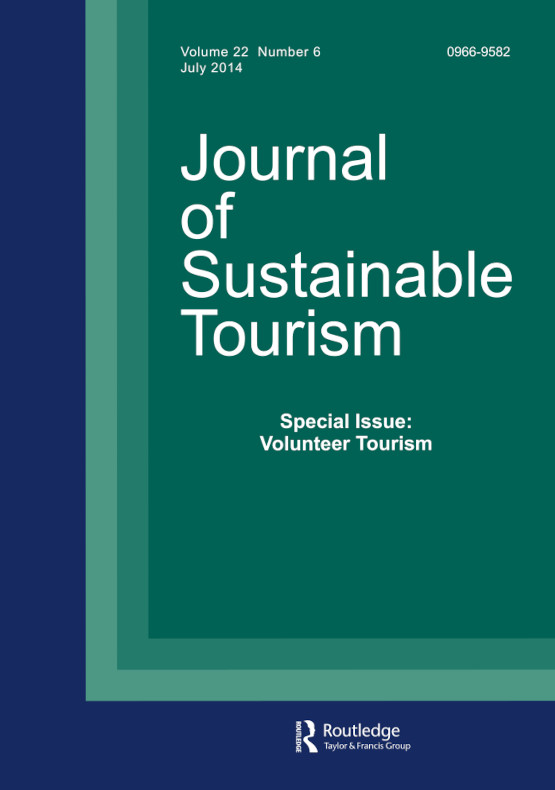绿色网红营销:概念化、规模发展与验证:在旅游产品中的应用
IF 7.8
2区 管理学
Q2 GREEN & SUSTAINABLE SCIENCE & TECHNOLOGY
引用次数: 0
摘要
摘要本研究旨在概念化绿色影响者营销(GIM),并编制绿色影响者营销的测量量表。为了实现这一目标,本研究采用了顺序探索性混合方法设计。在此背景下,分别进行了定性研究和定量研究。研究1为定性研究,研究2、3、4为定量研究。在研究1中,对14位绿色影响者的社交媒体帖子进行了内容分析,以提供GIM的操作定义。通过内容分析,对绿色网红营销及其子因子环境友好型产品导向影响和环境可持续性导向影响进行了概念化,并得到了一个15项池。研究2、3和4的定量数据是从追随14位绿色影响者中的至少一位的参与者那里收集的。在定量研究中,采用了多波数据收集。在研究2中,通过定量研究对项目池进行纯化和提炼。因此,得到了一个由2个维度8个项目组成的量表(n:100)。在研究3中,通过重测法(n:202)确定了量表的因子结构。在研究4中,采用刺激-有机体-反应(S-O-R)理论假设的研究模型进行了检验,以确保量表的法效度(n:321)。法效度研究模型由GIM、个人兴趣感知契合度、绿色行为意向和环境意识变量组成。GIM采用本研究开发的8项双因子量表进行测量。与个人兴趣的感知契合度是用一个三项目量表来测量的,该量表改编自Casaló等人。绿色行为意向的测量采用了由Jain等人改编的四项量表。使用Huang等人开发的八项量表来测量环境意识。研究发现,环境友好型产品导向影响和环境可持续性导向影响显著预测绿色旅游产品的行为意愿。因此,本研究通过概念化GIM并开发其量表,对文献做出了有价值的贡献。关键词:绿色影响者营销规模发展刺激-机体反应理论绿色行为意向绿色旅游产品披露声明作者未报告潜在利益冲突。本文章由计算机程序翻译,如有差异,请以英文原文为准。
Green influencer marketing: conceptualization, scale development, and validation: an application to tourism products
AbstractThis study aims to conceptualize the green influencer marketing (GIM) and to develop a GIM scale for its measurement. To achieve this goal, this research used a sequential exploratory mixed-methods design. In this context, qualitative study and quantitative studies were carried out, respectively. Study 1 included qualitative study, while study 2, 3 and 4 included quantitative studies. In the study 1, the social media posts of 14 green influencers were subjected to the content analysis to provide an operational definition of the GIM. With this content analysis, green influencer marketing and its sub-factors, which are environmentally friendly product-oriented influence and environmental sustainability-oriented influence, were conceptualized and a 15-item pool was obtained. Quantitative data for study 2, 3 and 4 were collected from participants who followed at least one of the 14 green influencers. In the quantitative studies, multiple waves of data collection were used. In the study 2, the item pool was purified and refined with the help of quantitative research. Thus, a scale consisting of 2 dimensions and 8 items was obtained (n:100). In the study 3, the factor structure of the scale was confirmed through the test-retest method (n:202). In the study 4, the research model hypothesized using the Stimulus-Organism-Response (S-O-R) Theory was tested to ensure the nomological validity of the scale (n:321). The research model built for nomological validity consists of GIM, perceived fit with personal interests, green behavioral intention, and environmental consciousness variables. GIM was measured using an 8-item and two-factor scale developed in this study. Perceived fit with personal interests was measured using a three-item scale adapted from Casaló et al. Green behavioral Intention was measured using a four-item scale adapted from Jain et al. An eight-item scale developed by Huang et al. was utilized to measure environmental consciousness. According to the findings, environmentally friendly product-oriented influence and environmental sustainability-oriented influence significantly predicted behavioural intention towards green tourism products. As a result, this research makes a valuable contribution to the literature by conceptualizing the GIM and developing its scale.Keywords: Green influencer marketingscale developmentstimulus-organism-response theorygreen behavioural intentiongreen tourism products Disclosure statementNo potential conflict of interest was reported by the author(s).
求助全文
通过发布文献求助,成功后即可免费获取论文全文。
去求助
来源期刊

Journal of Sustainable Tourism
Multiple-
CiteScore
23.10
自引率
8.90%
发文量
91
期刊介绍:
The Journal of Sustainable Tourism advances critical understanding of the relationships between tourism and sustainable development. The journal publishes theoretical, conceptual and empirical research that explores one or more of the economic, social, cultural, political, organisational or environmental aspects of the subject.
The Journal of Sustainable Tourism encourages critical views, as well as new ideas and approaches in relation to the theory and practice linking tourism and sustainability.
 求助内容:
求助内容: 应助结果提醒方式:
应助结果提醒方式:


